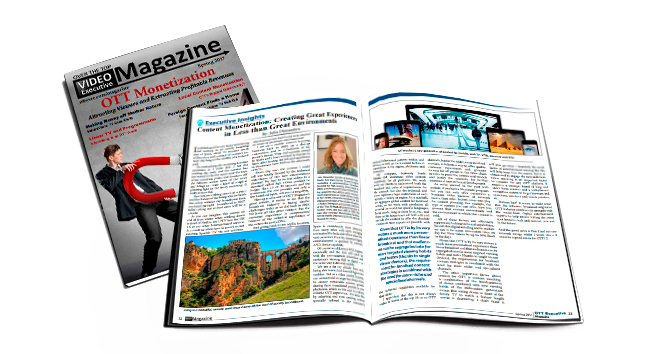[SFM ARTICLE] OTT: Creating A Great Content Experience In A Less Than Great Environment

As published in OTT Magazine
I’m British and I’m very lucky to be living and working in an utterly beautiful part of Spain, about 30 minutes south of Barcelona and around 15 minutes in-land, slap bang in the middle of a natural park.
 I’m overlooking the sweeping Catalan mountains as I write this. I hit the working day early and the sunrise has just started to do the same over the tops of the mountain peaks and bounces off the different winter hews of the trees and foliage to create a kind of magical glittering light in the frosty morning. It really is beautiful.
I’m overlooking the sweeping Catalan mountains as I write this. I hit the working day early and the sunrise has just started to do the same over the tops of the mountain peaks and bounces off the different winter hews of the trees and foliage to create a kind of magical glittering light in the frosty morning. It really is beautiful.
However, everything comes at a price and the chances of me being able to finish this article without my broadband (yes, you heard me right – broadband in 2017, folks) cutting out at least once will be miracle.
As you can imagine, this causes no end of frustrations when settling down in front of Netflix, my IPTV box for UK TV, or any other Internet based service. As a result we often have to revert to just watching Spanish TV via our antenna, which leaves a lot to be desired in terms of premium entertainment, I can tell ya!
I set up a mobile content licensing business back in 2003, on a dial-up connection and in a bedroom of my parent’s house. They had recently retired to Spain and I had returned to Europe in haste after leaving my job and apartment in downtown New York in the aftermath of 9/11.
From day one, the content I could sell was totally limited by the technical restrictions of this new entertainment channel. We had to format videos to a standard called 3gp, videos couldn’t be longer than 15 or 30 seconds and the maximum file size possible was only a few hundred bytes, not even a megabyte.
 Having read many of OTT Magazine’s great articles, it seems to me that the broadcast industry is facing similar challenges today as we did back in 2003. We have all this great content, but the customer experience is compromised because of the technical capabilities of the networks and CDNs.
Having read many of OTT Magazine’s great articles, it seems to me that the broadcast industry is facing similar challenges today as we did back in 2003. We have all this great content, but the customer experience is compromised because of the technical capabilities of the networks and CDNs.
And going back to my idyllic location, Spain is considerably more advanced than many other wide open emerging territories like India and Africa where the vast consumer thirst for streamed digital entertainment is quashed by network AND device capability.
Of course we all know it WILL happen eventually and the tech will catch up with the entertainment innovation and customer’s viewing shift to digital – in the same way it did with mobile.
We are a far cry already from only being able to watch a 15 second 3gp on our mobiles. But as a video content licensor, my commercial strategy has always been to ensure sustainable revenue growth during these transitional periods to new platforms, which in this case is a robust, reliable OTT experience. I’ve done this by adapting and even creating content specially tailored to the consumer’s natural behavioural patterns within said devices as well as the localised technical capabilities of the region, platforms and networks.
 My company, Seriously Fresh Media Ltd, distributes video content worldwide for all platforms. We work with our clients to understand both the localised and cultural requirements for the content, but also the technical and even regulatory legal restrictions of each specific country or region.
My company, Seriously Fresh Media Ltd, distributes video content worldwide for all platforms. We work with our clients to understand both the localised and cultural requirements for the content, but also the technical and even regulatory legal restrictions of each specific country or region.
In a nutshell, we aggregate global content for localised needs, so we work with producers all around the world for specific languages, local trends, long or short form, etc., and then our in-house team will both edit and encode the content to offer the absolute maximum user experience possible with the technical capabilities available for that client.
I appreciate that this is not always a viable in terms of the top 10 or so OTT channels, but for the wider, more localised services, it delivers a way to offer quality customer experiences and generate income for all parties in the value chain in order to prove the commercial models and justify the necessity for further investment into technical development.
As we’ve learned in the past with mobile, if you have a 30-minute program, but you can only offer customers a 5-minute video because of network issues, then other factors come into play for content planning. For example, the type of content you can offer, how you present that content contextually and the environment in which that content is sold.
All of these factors can effectively support any lacking technical capabilities. We call this digital retailing and in mobile we saw it increase conversion rates on Pay Per View videos by up to 30% (back in the day).
Given that OTT is by its very nature a much more personalised experience than linear broadcast and that audiences can be segregated into far more targeted viewing habits and tastes (thanks to single viewer devices), the requirement for localised content strategies is combined with the need for more niche and specialised channels.
The other important factor about content for OTT is content snacking. A combination of the bombardment of choice combined with new viewing habits of the millennium generation means that sitting down in front of the family TV to watch a feature length movie is decreasing. I don’t think it will ever go away – hopefully the social factor of entertainment viewing like this will help keep it in the matrix, but to a) obtain and b) engage the new audiences, video snacking is an important factor to consider for any OTT platform. It requires a strategic blend of long and short form content and a well-planned navigation system to target browsers and searchers, snackers and couch potatoes, etc.
Bottom line? It seems to make sense that the inherent broadcast-originated OTT industry combines its strengths with the native-born digital entertainment experts to help ensure hitting the sweet spot between tech and content, now and in the future.
And the good news is that I had not one network outage whilst I wrote this – it must be a good omen for OTT!
If you have an OTT / VOD service or are planning to launch one, email info@seriouslyfreshmedia.com to discover how we can support your content roadmap more effectively.
Julia Dimambro
CEO and Founder, Seriously Fresh Media
julia@seriouslyfreshmedia.com
https://www.seriouslyfreshmedia.com

